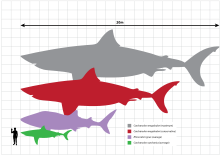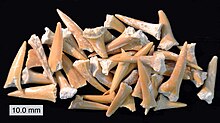Sunday, September 30, 2018
Saturday, September 29, 2018
Sunday, September 23, 2018
Sharks are a group of elasmobranch fish characterized by a cartilaginous skeleton, five to seven gill slits on the sides of the head, and pectoral fins that are not fused to the head. Modern sharks are classified within the clade Selachimorpha (or Selachii) and are the sister group to the rays. However, the term "shark" has also been used for extinct members of the subclass Elasmobranchii outside the Selachimorpha, such as Cladoselache and Xenacanthus, as well as other Chondrichthyes such as the holocephalid eugenedontidans.
Under this broader definition, the earliest known sharks date back to more than 420 million years ago.[2] Acanthodians are often referred to as "spiny sharks"; though they are not part of Chondrichthyes proper, they are a paraphyletic assemblage leading to cartilaginous fish as a whole. Since then, sharks have diversified into over 500 species. They range in size from the small dwarf lanternshark (Etmopterus perryi), a deep sea species of only 17 centimetres (6.7 in) in length, to the whale shark (Rhincodon typus), the largest fish in the world, which reaches approximately 12 metres (40 ft) in length. Sharks are found in all seas and are common to depths of 2,000 metres (6,600 ft). They generally do not live in freshwater although there are a few known exceptions, such as the bull shark and the river shark, which can survive and be found in both seawater and freshwater.[3] Sharks have a covering of dermal denticles that protects their skin from damage and parasites in addition to improving their fluid dynamics. They have numerous sets of replaceable teeth.[4]
Well-known species such as the great white shark, tiger shark, blue shark, mako shark, thresher shark, and hammerhead shark are apex predators—organisms at the top of their underwater food chain. Many shark populations are threatened by human activities.
 Until the 16th century,[5] sharks were known to mariners as "sea dogs".[6] This is still evidential in several species termed "dogfish," or the porbeagle.
Until the 16th century,[5] sharks were known to mariners as "sea dogs".[6] This is still evidential in several species termed "dogfish," or the porbeagle.
The etymology of the word "shark" is uncertain, the most likely etymology states that the original sense of the word was that of "predator, one who preys on others" from the Dutch schurk, meaning "villain, scoundrel" (cf. card shark, loan shark, etc.), which was later applied to the fish due to its predatory behaviour.[7]
A now disproven theory is that it derives from the Yucatec Maya word xok (pronounced 'shok'), meaning "fish".[8] Evidence for this etymology came from the Oxford English Dictionary, which notes shark first came into use after Sir John Hawkins' sailors exhibited one in London in 1569 and posted "sharke" to refer to the large sharks of the Caribbean Sea. However, the Middle English Dictionary records an isolated occurrence of the word shark (referring to a sea fish) in a letter written by Thomas Beckington in 1442, which rules out a New World etymology.[9]
See also: Evolution of fish
Evidence for the existence of sharks dates from the Ordovician period, 450–420 million years ago, before land vertebrates existed and before a variety of plants had colonized the continents.[2] Only scales have been recovered from the first sharks and not all paleontologists agree that these are from true sharks, suspecting that these scales are actually those of thelodont agnathans.[10] The oldest generally accepted shark scales are from about 420 million years ago, in the Silurian period.[10] The first sharks looked very different from modern sharks.[11] At this time the most common shark tooth is the cladodont, a style of thin tooth with three tines like a trident, apparently to help catch fish. The majority of modern sharks can be traced back to around 100 million years ago.[12] Most fossils are of teeth, often in large numbers. Partial skeletons and even complete fossilized remains have been discovered. Estimates suggest that sharks grow tens of thousands of teeth over a lifetime, which explains the abundant fossils. The teeth consist of easily fossilized calcium phosphate, an apatite. When a shark dies, the decomposing skeleton breaks up, scattering the apatite prisms. Preservation requires rapid burial in bottom sediments.
Among the most ancient and primitive sharks is Cladoselache, from about 370 million years ago,[11] which has been found within Paleozoic strata in Ohio, Kentucky, and Tennessee. At that point in Earth's history these rocks made up the soft bottom sediments of a large, shallow ocean, which stretched across much of North America. Cladoselache was only about 1 metre (3.3 ft) long with stiff triangular fins and slender jaws.[11] Its teeth had several pointed cusps, which wore down from use. From the small number of teeth found together, it is most likely that Cladoselache did not replace its teeth as regularly as modern sharks. Its caudal fins had a similar shape to the great white sharks and the pelagic shortfin and longfin makos. The presence of whole fish arranged tail-first in their stomachs suggest that they were fast swimmers with great agility.
Most fossil sharks from about 300 to 150 million years ago can be assigned to one of two groups. The Xenacanthida was almost exclusive to freshwater environments.[13][14] By the time this group became extinct about 220 million years ago, they had spread worldwide. The other group, the hybodonts, appeared about 320 million years ago and lived mostly in the oceans, but also in freshwater.[citation needed] The results of a 2014 study of the gill structure of an unusually well-preserved 325 million year old fossil suggested that sharks are not "living fossils", but rather have evolved more extensively than previously thought over the hundreds of millions of years they have been around.[15]

Megalodon (top two, estimated maximum and conservative sizes) with the whale shark, great white shark, and a human for scale
Modern sharks began to appear about 100 million years ago.[12] Fossil mackerel shark teeth date to the Early Cretaceous. One of the most recently evolved families is the hammerhead shark (family Sphyrnidae), which emerged in the Eocene.[16] The oldest white shark teeth date from 60 to 66 million years ago, around the time of the extinction of the dinosaurs. In early white shark evolution there are at least two lineages: one lineage is of white sharks with coarsely serrated teeth and it probably gave rise to the modern great white shark, and another lineage is of white sharks with finely serrated teeth. These sharks attained gigantic proportions and include the extinct megatoothed shark, C. megalodon. Like most extinct sharks, C. megalodon is also primarily known from its fossil teeth and vertebrae. This giant shark reached a total length (TL) of more than 16 metres (52 ft).[17][18] C. megalodon may have approached a maxima of 20.3 metres (67 ft) in total length and 103 metric tons (114 short tons) in mass.[19] Paleontological evidence suggests that this shark was an active predator of large cetaceans.[19]
 Sharks belong to the superorder Selachimorpha in the subclass Elasmobranchii in the class Chondrichthyes. The Elasmobranchii also include rays and skates; the Chondrichthyes also include Chimaeras. It was thought that the sharks form a polyphyletic group: some sharks are more closely related to rays than they are to some other sharks,[20] but current molecular studies support monophyly of both groups of sharks and batoids.[21][22]
Sharks belong to the superorder Selachimorpha in the subclass Elasmobranchii in the class Chondrichthyes. The Elasmobranchii also include rays and skates; the Chondrichthyes also include Chimaeras. It was thought that the sharks form a polyphyletic group: some sharks are more closely related to rays than they are to some other sharks,[20] but current molecular studies support monophyly of both groups of sharks and batoids.[21][22]
The superorder Selachimorpha is divided into Galea (or Galeomorphii), and Squalea (or Squalomorphii). The Galeans are the Heterodontiformes, Orectolobiformes, Lamniformes, and Carcharhiniformes. Lamnoids and Carcharhinoids are usually placed in one clade, but recent studies show the Lamnoids and Orectoloboids are a clade. Some scientists now think that Heterodontoids may be Squalean. The Squaleans are divided into Hexanchiformes and Squalomorpha. The former includes cow shark and frilled shark, though some authors propose both families to be moved to separate orders. The Squalomorpha contains the Squaliformes and the Hypnosqualea. The Hypnosqualea may be invalid. It includes the Squatiniformes, and the Pristorajea, which may also be invalid, but includes the Pristiophoriformes and the Batoidea.[20][23]
There are more than 470 species of sharks split across thirteen orders, including four orders of sharks that have gone extinct:[23]
- Carcharhiniformes: Commonly known as ground sharks, the order includes the blue, tiger, bull, grey reef, blacktip reef, Caribbean reef, blacktail reef, whitetip reef, and oceanic whitetip sharks (collectively called the requiem sharks) along with the houndsharks, catsharks, and hammerhead sharks. They are distinguished by an elongated snout and a nictitating membrane which protects the eyes during an attack.
- Heterodontiformes: They are generally referred to as the bullhead or horn sharks.
- Hexanchiformes: Examples from this group include the cow sharks and frilled sharks, which somewhat resembles a marine snake.
- Lamniformes: They are commonly known as the mackerel sharks. They include the goblin shark, basking shark, megamouth shark, the thresher sharks, shortfin and longfin mako sharks, and great white shark. They are distinguished by their large jaws and ovoviviparous reproduction. The Lamniformes also include the extinct megalodon, Carcharodon megalodon.
- Orectolobiformes: They are commonly referred to as the carpet sharks, including zebra sharks, nurse sharks, wobbegongs, and the whale shark.
- Pristiophoriformes: These are the sawsharks, with an elongated, toothed snout that they use for slashing their prey.
- Squaliformes: This group includes the dogfish sharks and roughsharks.
- Squatiniformes: Also known as angel sharks, they are flattened sharks with a strong resemblance to stingrays and skates.
- † Cladoselachiformes
- † Hybodontiformes
- † Symmoriida
- † Xenacanthida (Xenacantiformes)
Friday, September 21, 2018
Wednesday, September 19, 2018
Tuesday, September 11, 2018
Sunday, September 9, 2018
Tuesday, September 4, 2018
Subscribe to:
Comments (Atom)





